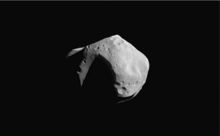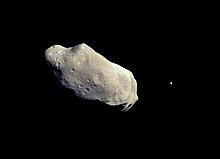
Asteroids are minor planets, especially those of the inner Solar System. The larger ones have also been called planetoids. These terms have historically been applied to any astronomical object orbiting the Sun that did not show the disk of a planet and was not observed to have the characteristics of an active comet, but as minor planets in the outer Solar System were discovered, their volatile-based surfaces were found to more closely resemble comets and so were often distinguished from traditional asteroids. Thus the term asteroid has come increasingly to refer specifically to the small bodies of the inner Solar System out to the orbit of Jupiter. They are grouped with the outer bodies—centaurs, Neptune trojans, and trans-Neptunian objects—as minor planets, which is the term preferred in astronomical circles. In this article the term "asteroid" refers to the minor planets of the inner Solar System.
There are millions of asteroids, many thought to be the shattered remnants of planetesimals, bodies within the young Sun's solar nebula that never grew large enough to become planets. The large majority of known asteroids orbit in the asteroid belt between the orbits of Mars and Jupiter or co-orbital with Jupiter (the Jupiter Trojans). However, other orbital families exist with significant populations, including the near-Earth asteroids. Individual asteroids are classified by their characteristic spectra, with the majority falling into three main groups: C-type, S-type, and M-type. These were named after and are generally identified with carbon-rich, stony, and metallic compositions, respectively.
Only one asteroid, 4 Vesta, which has a relatively reflective surface, is normally visible to the naked eye, and this only in very dark skies when it is favorably positioned. Rarely, small asteroids passing close to Earth may be visible to the naked eye for a short time. As of September 2013, the Minor Planet Center had data on more than one million objects, of which 625,106 had enough information to be given numbered designations.
Naming

A newly discovered asteroid is given a provisional designation (such as 2002 AT4) consisting of the year of discovery and an alphanumeric code indicating the half-month of discovery and the sequence within that half-month. Once an asteroid's orbit has been confirmed, it is given a number, and later may also be given a name (e.g. 433 Eros). The formal naming convention uses parentheses around the number (e.g. (433) Eros), but dropping the parentheses is quite common. Informally, it is common to drop the number altogether, or to drop it after the first mention when a name is repeated in running text.
Symbols
The first asteroids to be discovered were assigned iconic symbols like the ones traditionally used to designate the planets. By 1855 there were two dozen asteroid symbols, which often occurred in multiple variants.
| Asteroid | Symbol | Year | |
|---|---|---|---|
| 1 Ceres | ⚳ | Ceres' scythe, reversed to double as the letter C | 1801 |
| 2 Pallas | ⚴ | Athena's (Pallas') spear | 1801 |
| 3 Juno | ⚵ | A star mounted on a scepter, for Juno, the Queen of Heaven | 1804 |
| 4 Vesta | ⚶ | The altar and sacred fire of Vesta | 1807 |
| 5 Astraea | A scale, or an inverted anchor, symbols of justice | 1845 | |
| 6 Hebe | Hebe's cup | 1847 | |
| 7 Iris | A rainbow (iris) and a star | 1847 | |
| 8 Flora | A flower (flora) (specifically the Rose of England) | 1847 | |
| 9 Metis | The eye of wisdom and a star | 1848 | |
| 10 Hygiea | Hygiea's serpent and a star, or the Rod of Asclepius | 1849 | |
| 11 Parthenope | A harp, or a fish and a star; symbols of the sirens | 1850 | |
| 12 Victoria | The laurels of victory and a star | 1850 | |
| 13 Egeria | A shield, symbol of Egeria's protection, and a star | 1850 | |
| 14 Irene | A dove carrying an olive branch (symbol of irene 'peace') with a star on its head, or an olive branch, a flag of truce, and a star | 1851 | |
| 15 Eunomia | A heart, symbol of good order (eunomia), and a star | 1851 | |
| 16 Psyche | A butterfly's wing, symbol of the soul (psyche), and a star | 1852 | |
| 17 Thetis | A dolphin, symbol of Thetis, and a star | 1852 | |
| 18 Melpomene | The dagger of Melpomene, and a star | 1852 | |
| 19 Fortuna | The wheel of fortune and a star | 1852 | |
| 26 Proserpina | Proserpina's pomegranate | 1853 | |
| 28 Bellona | Bellona's whip and lance | 1854 | |
| 29 Amphitrite | The shell of Amphitrite and a star | 1854 | |
| 35 Leukothea | A lighthouse beacon, symbol of Leucothea | 1855 | |
| 37 Fides | The cross of faith (fides) | 1855 | |
Discovery

The first asteroid to be discovered, Ceres, was found in 1801 by Giuseppe Piazzi, and was originally considered to be a new planet. This was followed by the discovery of other similar bodies, which, with the equipment of the time, appeared to be points of light, like stars, showing little or no planetary disc, though readily distinguishable from stars due to their apparent motions. This prompted the astronomer Sir William Herschel to propose the term "asteroid", coined in Greek as ἀστεροειδής asteroeidēs 'star-like, star-shaped', from Ancient Greek ἀστήρ astēr 'star, planet'. In the early second half of the nineteenth century, the terms "asteroid" and "planet" (not always qualified as "minor") were still used interchangeably; for example, the Annual of Scientific Discovery for 1871, page 316, reads "Professor J. Watson has been awarded by the Paris Academy of Sciences, the astronomical prize, Lalande foundation, for the discovery of eight new asteroids in one year. The planet Lydia (No. 110), discovered by M. Borelly at the Marseilles Observatory [...] M. Borelly had previously discovered two planets bearing the numbers 91 and 99 in the system of asteroids revolving between Mars and Jupiter".

Tidak ada komentar:
Posting Komentar